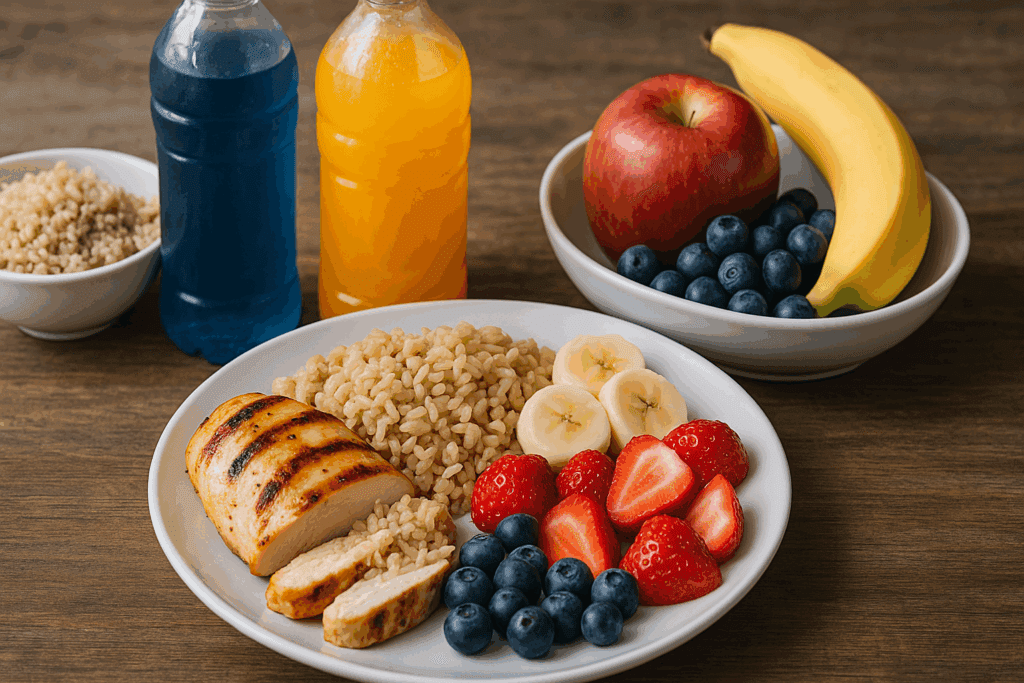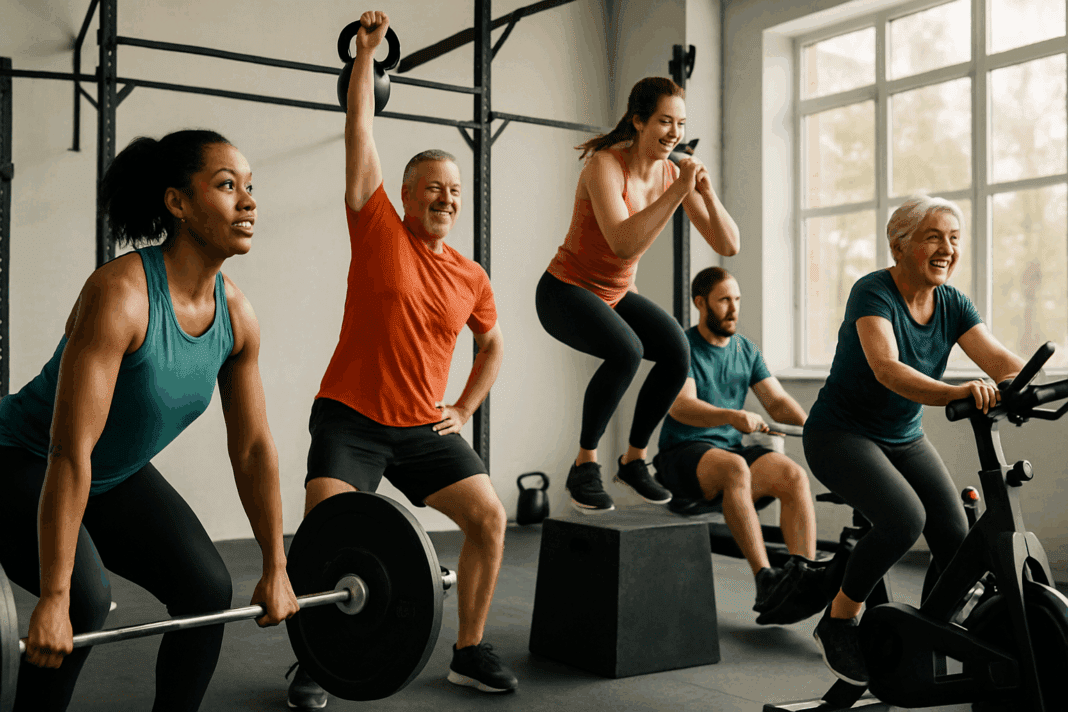Introduction: The Natural Connection Between Fitness and Lasting Performance
In an era where quick fixes and extreme workout trends often take center stage, it is essential to re-center the conversation around sustainable, evidence-based strategies for enhancing athletic performance. The human body is an extraordinary system capable of incredible adaptation and growth when approached with consistency, intelligence, and care. This article explores how a fit gym workout, rooted in science-backed training principles, can foster lasting endurance and strength improvements without compromising safety. With a particular emphasis on how performance enhancement can be achieved through natural, holistic methods, we will also explore the benefits of a comprehensive fitness exercise gym routine that aligns with long-term health and athletic goals.
Whether you’re a seasoned athlete or someone looking to elevate your physical capabilities, understanding how to harness your body’s potential through structured training can significantly improve stamina, reduce the risk of injury, and enhance overall well-being. In the pages that follow, we dive deep into the physiology of endurance, the mechanics of power development, and the integral role of consistency, nutrition, and recovery. Central to this journey is not just physical exertion, but also a mindset grounded in resilience and balance—principles that turn every visit to the gym into an opportunity for transformation.
You may also like: How to Increase Stamina and Endurance Naturally: Smart Training Tips and Nutrition Habits That Support Cardiovascular Fitness

The Foundations of a Fit Gym Workout: More Than Just Muscles
A truly effective fit gym workout does more than build visible muscle mass. At its core, it optimizes cardiovascular efficiency, boosts neuromuscular coordination, enhances energy metabolism, and improves mental resilience. These benefits do not arise from random effort, but from intelligently designed routines that prioritize form, function, and recovery. Such a program typically incorporates aerobic and anaerobic conditioning, resistance training, and functional movements that mirror real-life demands.
The success of a fitness exercise gym routine lies in its ability to adapt to individual needs and progression levels. Beginners may start with foundational strength movements like squats, push-ups, and deadlifts, while more advanced trainees may implement periodized plans involving progressive overload, plyometric drills, or high-intensity interval training. Each element contributes uniquely to improving endurance and power, but together they offer a holistic pathway to physical transformation.
Importantly, science supports this approach. Research consistently shows that varied, well-structured workout routines enhance mitochondrial density, which translates to improved muscular endurance and oxygen delivery during prolonged efforts. Moreover, strength training—especially compound lifts—activates multiple muscle groups, stimulating anabolic hormones that facilitate both strength and stamina. For anyone pursuing long-term results, a fit gym workout is not merely an option; it is a foundational practice rooted in physiological wisdom.

The Role of Progressive Overload in Power and Stamina Gains
Progressive overload is a central concept in both endurance and strength development. It refers to the gradual increase of stress placed upon the body during training. This stress could take the form of added resistance, increased training volume, higher frequency, or greater intensity. When applied correctly, progressive overload stimulates physiological adaptations that result in more robust muscular, cardiovascular, and neurological performance.
One of the most effective ways to implement this principle in a fitness exercise gym setting is through structured periodization. Periodization involves organizing training into cycles that vary in focus and intensity. For instance, a mesocycle might prioritize hypertrophy in one phase and strength or endurance in the next. This approach prevents stagnation, reduces the risk of overtraining, and maximizes long-term progress.
It is important to highlight that while progressive overload fuels progress, it must be applied with precision and patience. Excessive increases in workload without adequate recovery can lead to overtraining, compromised immunity, and even injury. Conversely, a well-regulated plan that incrementally challenges the body fosters resilience, muscle hypertrophy, and aerobic expansion—all critical components of enhanced performance.

Integrating Cardiovascular Conditioning for Endurance and Recovery
While resistance training forms the backbone of many gym routines, cardiovascular conditioning is essential for those seeking to build true endurance. Aerobic fitness enables the body to sustain activity for extended periods by improving the efficiency of the heart, lungs, and circulatory system. This not only enhances stamina but also accelerates recovery between bouts of intense physical effort.
Effective cardiovascular training in a fitness exercise gym can take many forms, from steady-state treadmill runs to interval cycling, rowing, or circuit training. The key is to tailor these activities to one’s goals and to strike the right balance between intensity and volume. For endurance athletes, longer sessions at moderate intensity build aerobic capacity, while sprinters and powerlifters may benefit more from short, high-intensity intervals that increase anaerobic threshold and lactate tolerance.
What’s often overlooked is how cardiovascular fitness supports muscular recovery. A well-conditioned cardiovascular system improves nutrient and oxygen delivery to tissues, expedites waste removal, and helps regulate hormonal balance. Together, these benefits make cardiovascular training an indispensable part of any comprehensive fit gym workout, not only boosting performance but safeguarding health in the process.

Strength Training Strategies That Prioritize Functional Power
In the pursuit of performance enhancement, strength training must be about more than lifting heavier weights—it should focus on cultivating usable, functional power. Functional strength involves training the body to perform real-world activities more efficiently and safely. This means incorporating multi-joint movements that recruit multiple muscle groups and require coordination, stability, and core engagement.
Exercises such as deadlifts, squats, lunges, overhead presses, and pull-ups are not just gym staples—they are foundational movements that develop functional strength. Adding instability elements, like using a BOSU ball or suspension trainer, can further enhance proprioception and joint stability. Moreover, explosive lifts such as power cleans and kettlebell swings recruit fast-twitch muscle fibers essential for sprinting, jumping, and lifting under pressure.
A fit gym workout that emphasizes functional training not only increases muscle mass and strength but also improves neuromuscular efficiency. This has practical implications for sports performance, injury prevention, and even daily living. For aging populations or individuals recovering from injuries, the ability to move dynamically and with control can be the difference between independence and dependence.
The Science of Recovery: Why Rest Days Build Strength
In the relentless pursuit of progress, rest is often underestimated. Yet recovery is not a passive phase—it is when the most critical adaptations take place. Muscles grow, neural pathways consolidate, and hormones rebalance during periods of rest. Without adequate recovery, even the most rigorous fit gym workout can become counterproductive, leading to fatigue, inflammation, and regression.
Recovery strategies should be as intentional as training itself. These include proper sleep hygiene, active recovery activities (such as light walking or yoga), hydration, and balanced nutrition. Sleep, in particular, is a cornerstone of recovery. During deep sleep phases, the body releases growth hormone, which plays a pivotal role in tissue repair and energy restoration.
Additionally, incorporating mobility work, foam rolling, and stretching can accelerate muscle recovery and reduce the risk of injury. When recovery becomes an integral part of your fitness exercise gym routine, performance gains are not only more likely—they are also more sustainable. Rather than viewing rest days as breaks from training, consider them strategic investments in long-term endurance and power.

The Power of Nutrition in Endurance and Strength Building
No training program, however well-designed, can outpace poor nutrition. The body’s performance capacity is intricately tied to the quality and timing of nutrient intake. For those engaged in demanding fitness routines, macronutrients—protein, carbohydrates, and fats—must be consumed in the right ratios to support muscle synthesis, replenish glycogen stores, and facilitate recovery.
Protein is especially critical for repairing muscle tissue broken down during resistance training. Sources such as lean meats, legumes, and dairy products provide essential amino acids that fuel growth and adaptation. Carbohydrates, on the other hand, are the primary energy source for both aerobic and anaerobic exercise. Complex carbs like whole grains and vegetables offer sustained energy without spiking insulin levels excessively.
Fat, though often misunderstood, plays an essential role in hormone production and joint lubrication. Omega-3 fatty acids, found in fish and flaxseeds, can even help reduce exercise-induced inflammation. Hydration is equally important. Even mild dehydration can impair cognitive function and endurance capacity. Thus, for those embracing a fit gym workout lifestyle, prioritizing whole-food nutrition and strategic supplementation can markedly improve training outcomes and long-term vitality.
Psychological Resilience and Motivation in Long-Term Training
Physical transformation is as much a mental journey as it is a physiological one. The commitment to a consistent fitness exercise gym routine requires discipline, resilience, and a strong sense of purpose. Motivation ebbs and flows, and the ability to stay the course through challenges, plateaus, and setbacks is what ultimately determines long-term success.
Building psychological resilience involves cultivating a growth mindset. Instead of seeing obstacles as failures, resilient athletes view them as learning opportunities. Setting realistic, incremental goals fosters a sense of achievement that reinforces motivation. Visualization techniques, positive self-talk, and mindfulness practices also help sharpen focus and reduce performance anxiety.
Community support is another powerful motivator. Training with a partner or participating in group classes can enhance accountability and add a social dimension to fitness. Additionally, tracking progress—whether through a journal, app, or wearable device—provides tangible proof of growth and encourages continued effort. In the grand scheme of performance enhancement, mental fortitude is the invisible muscle that makes every lift stronger and every mile more meaningful.

Customizing Your Fitness Exercise Gym Routine for Personalized Results
One of the most empowering aspects of modern fitness is the ability to customize training based on individual goals, body types, and lifestyle constraints. There is no one-size-fits-all approach, and the best fit gym workout is one that aligns with your unique physiology, preferences, and aspirations. This personalized approach increases adherence and maximizes outcomes.
Variables such as age, gender, training history, and existing health conditions should all inform the design of your workout plan. For instance, a 50-year-old novice might focus on joint mobility, low-impact cardio, and gradual resistance, whereas a young athlete might thrive on Olympic lifts and sprint intervals. Likewise, someone recovering from injury may need to modify intensity or include rehabilitation exercises.
Technology can aid customization. Fitness apps, heart rate monitors, and wearable trackers provide real-time feedback that allows you to fine-tune your effort and recovery. Periodic assessments—such as strength tests, VO2 max evaluations, or body composition scans—can further guide your training evolution. Ultimately, the most effective fitness exercise gym routine is one that grows with you, challenges you appropriately, and aligns with your values and lifestyle.
Frequently Asked Questions: Fit Gym Workout and Fitness Exercise Gym Performance
What are some often-overlooked tools or equipment that can enhance a fit gym workout?
Many people focus on weights and machines, but incorporating unconventional tools can dramatically boost the effectiveness of a fit gym workout. Resistance bands, for example, allow for controlled tension throughout a full range of motion and are excellent for mobility and rehab-focused routines. Slam balls and battle ropes are underused tools that challenge the core and cardiovascular system simultaneously, adding both endurance and explosive strength elements to your training. Suspension trainers like TRX devices improve balance and bodyweight control, which are essential for injury prevention and longevity in your workouts. Including these tools not only diversifies a fitness exercise gym routine but also helps develop muscles and movement patterns that traditional equipment may miss.
How can breath control impact performance during high-intensity sessions at the fitness exercise gym?
Breathwork is often underappreciated in a fitness exercise gym setting, yet it plays a critical role in endurance, focus, and recovery. Practicing diaphragmatic breathing helps regulate the nervous system, improving oxygen delivery during intense workouts. In strength-based exercises, exhaling during the exertion phase (like the upward motion of a squat) enhances core stability and can reduce the risk of injury. Athletes who integrate structured breath training—such as box breathing or rhythmic nasal breathing—often report higher stamina and mental clarity during long or complex fit gym workout sessions. Moreover, controlled breathing can accelerate post-exercise recovery by reducing cortisol levels and promoting parasympathetic activation.
What psychological techniques support long-term commitment to a fitness exercise gym routine?
Sustaining motivation for a consistent fitness exercise gym practice involves more than just willpower. Visualization techniques, where individuals mentally rehearse successful workouts, help reinforce positive neural pathways that associate gym attendance with achievement. Habit stacking—linking your fit gym workout with another established routine like morning coffee or a podcast—also increases adherence. Gamifying your experience through fitness trackers or goal-oriented challenges can stimulate dopamine-driven behavior reinforcement. Furthermore, practicing gratitude and mindfulness within your training context can deepen personal fulfillment, making the routine feel less like a chore and more like a powerful act of self-care. These psychological tools collectively help anchor exercise as a rewarding lifestyle choice rather than an obligation.
Can seasonal changes affect the efficiency of a fit gym workout?
Yes, seasonal shifts can significantly influence how your body responds to exercise, both physically and mentally. During colder months, joint stiffness and decreased flexibility may require extended warm-ups to prevent injury. Conversely, hot weather can elevate heart rate and sweat loss, demanding greater attention to hydration and electrolyte balance during any fitness exercise gym routine. Additionally, exposure to natural light impacts circadian rhythms and energy levels, which can subtly shift the times of day when you feel most motivated to train. Some athletes adjust their periodization plans seasonally—focusing on bulking or strength-building in winter and endurance or cutting phases in spring and summer. Adapting your fit gym workout to account for environmental and psychological factors can ensure year-round performance gains.
What role does gut health play in sustaining energy for workouts?
Gut health is increasingly recognized as a cornerstone of physical performance, especially for those engaging in rigorous fitness exercise gym sessions. A well-functioning gut microbiome supports optimal digestion and nutrient absorption, ensuring the body gets the fuel it needs from proteins, fats, and carbohydrates. When gut flora is out of balance, symptoms like bloating, fatigue, and impaired immune function can hinder your capacity to perform during a fit gym workout. Fermented foods such as kefir, kimchi, and yogurt, alongside prebiotic fibers from foods like oats and bananas, can enhance gut integrity. Integrating gut-friendly foods and possibly probiotics into your diet can support metabolic health, stabilize energy levels, and even influence mood—all of which play critical roles in sustaining an effective gym routine.
How can data-driven approaches personalize a fitness exercise gym plan?
The integration of biometric data is transforming how we approach training personalization in the gym. Using heart rate variability (HRV) monitors or smartwatches, individuals can tailor the intensity of their fit gym workout to match their current recovery status. This approach minimizes the risk of overtraining while maximizing performance on days when the body is primed for exertion. Additionally, sleep trackers and nutrition apps can provide insights into how lifestyle choices affect your energy and strength during a fitness exercise gym session. Some platforms even offer AI-driven coaching that adjusts your programming in real-time based on user input and performance trends. This data-informed methodology enables a smarter, more responsive fitness journey that evolves with your needs.
What are emerging trends in recovery that complement fit gym workout gains?
Recovery is evolving beyond static stretching and protein shakes. Today’s advanced recovery modalities include percussive therapy, cryotherapy, infrared sauna treatments, and compression gear—all designed to speed up tissue repair and reduce inflammation after intense training. These tools can be integrated seamlessly into your fitness exercise gym routine or used on off days to enhance mobility and circulation. Moreover, the rise of wearable tech that tracks muscle recovery zones allows users to plan workouts based on real-time feedback about which muscle groups are ready for action. These emerging strategies not only protect against injury but also improve consistency in training output, which is key for long-term gains in strength and stamina. Applying these recovery innovations alongside your fit gym workout can unlock new levels of progress and resilience.
Are there benefits to training at different times of the day in a fitness exercise gym?
Absolutely—timing can influence hormonal output, muscle strength, and even mental clarity during workouts. Morning gym-goers may benefit from higher cortisol levels that naturally spike upon waking, promoting fat metabolism and mental alertness during early-day training. Afternoon and early evening sessions, however, often coincide with peak body temperature and muscle flexibility, which can lead to enhanced performance in strength-based exercises. Matching your fit gym workout time with your chronotype—your natural circadian rhythm—can optimize energy expenditure and recovery. Additionally, experimenting with different times may reveal psychological preferences or logistical advantages that make your fitness exercise gym habit easier to maintain consistently.
What social dynamics in the gym influence individual performance and motivation?
Social interactions within the gym environment can powerfully shape training outcomes. Positive reinforcement from peers or coaches enhances self-efficacy, which directly impacts the intensity and frequency of participation in fitness exercise gym activities. Observing others’ progress can serve as a form of vicarious motivation, inspiring you to push beyond self-imposed limits. On the flip side, crowded or judgmental environments may cause anxiety or distraction, negatively affecting performance. Many people thrive in group training or semi-private sessions, where community support balances competitiveness and camaraderie. Choosing the right gym culture is therefore not just about equipment but about cultivating a space that aligns with your goals and mindset—a decision that can redefine your fit gym workout experience.
How does travel impact workout consistency, and what can be done to maintain results?
Frequent travel can disrupt fitness rhythms, but with preparation, it doesn’t have to derail your progress. Portable fitness tools like resistance bands or suspension trainers allow for a full-body fit gym workout even in a hotel room or park. Many modern fitness exercise gyms offer reciprocal memberships or day passes, making it easier to access equipment while away from home. Additionally, online training apps and virtual classes can provide structured guidance regardless of location. Maintaining nutritional habits and sleep hygiene while traveling is equally critical, as these directly influence your performance and recovery. By building a travel-ready fitness strategy, you can transform any disruption into an opportunity for creative movement and continued progress.
Conclusion: Enhancing Performance the Smart, Natural Way with a Fit Gym Workout
At its essence, the journey toward greater endurance and power is one of mastery over time, intention, and effort. A fit gym workout is not simply about lifting weights or burning calories; it is a structured, evolving practice that harmonizes body, mind, and purpose. When executed thoughtfully, it becomes a powerful vehicle for natural performance enhancement, one grounded not in fads or shortcuts but in science, strategy, and self-awareness.
By integrating cardiovascular conditioning, functional strength training, progressive overload, strategic recovery, balanced nutrition, and mental resilience, you construct a multidimensional approach to fitness that transcends aesthetics. It prioritizes capability, sustainability, and overall vitality. Whether your goal is to run a marathon, improve your energy levels, or simply age with grace and strength, the principles discussed here can guide your way.
Let your fitness exercise gym routine become a cornerstone of your lifestyle—one that empowers you to push boundaries, adapt intelligently, and perform at your best, not just today, but for years to come. In a world full of fast fixes and fleeting trends, choose the path of enduring strength, built naturally from the inside out.
Was this article helpful? Don’t let it stop with you. Share it right now with someone who needs to see it—whether it’s a friend, a colleague, or your whole network. And if staying ahead on this topic matters to you, subscribe to this publication for the most up-to-date information. You’ll get the latest insights delivered straight to you—no searching, no missing out.
Further Reading:
How to Increase Stamina: 16 Ways to Power Up a Workout

